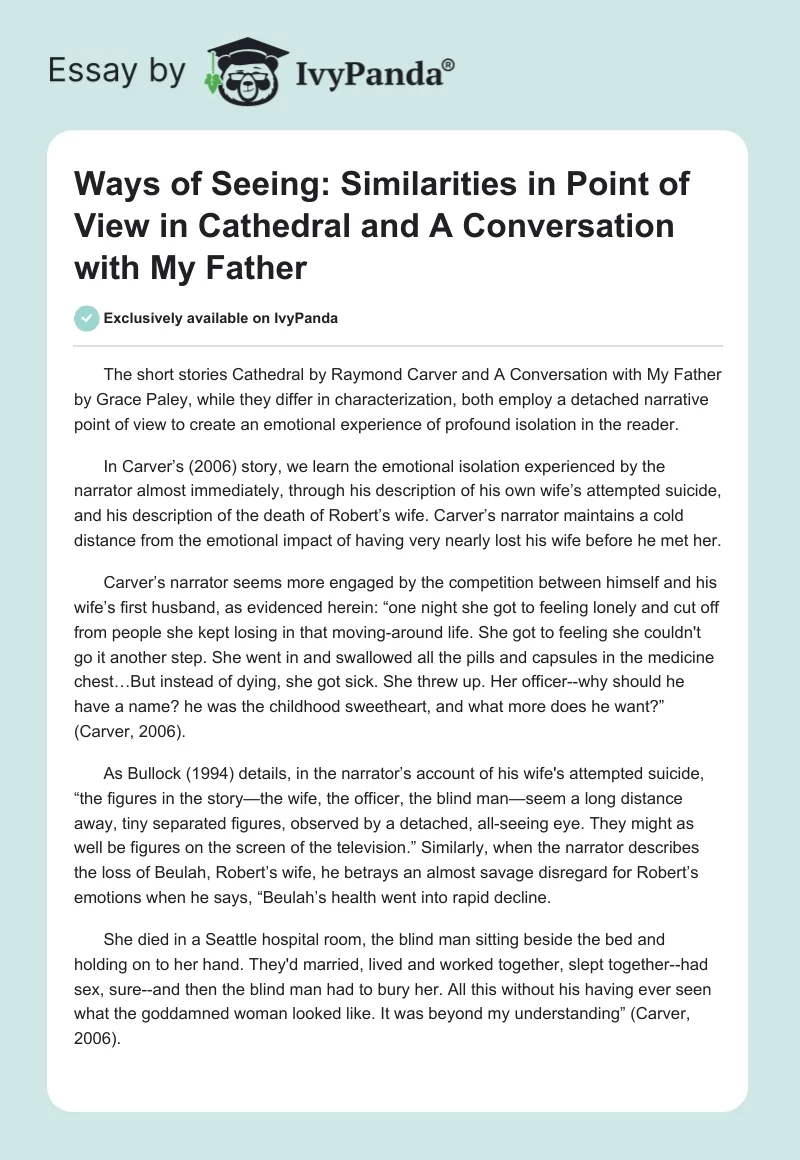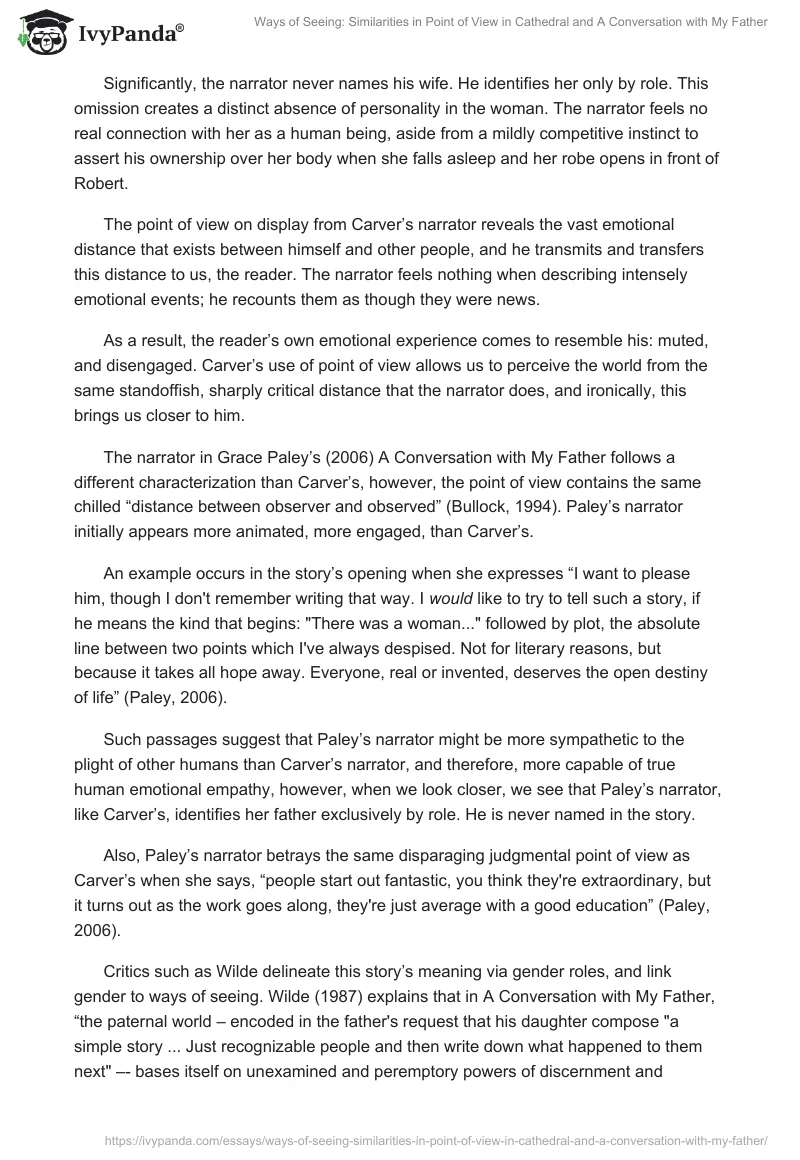The short stories Cathedral by Raymond Carver and A Conversation with My Father by Grace Paley, while they differ in characterization, both employ a detached narrative point of view to create an emotional experience of profound isolation in the reader.
In Carver’s (2006) story, we learn the emotional isolation experienced by the narrator almost immediately, through his description of his own wife’s attempted suicide, and his description of the death of Robert’s wife. Carver’s narrator maintains a cold distance from the emotional impact of having very nearly lost his wife before he met her.
Carver’s narrator seems more engaged by the competition between himself and his wife’s first husband, as evidenced herein: “one night she got to feeling lonely and cut off from people she kept losing in that moving-around life. She got to feeling she couldn’t go it another step. She went in and swallowed all the pills and capsules in the medicine chest…But instead of dying, she got sick. She threw up. Her officer–why should he have a name? he was the childhood sweetheart, and what more does he want?” (Carver, 2006).
As Bullock (1994) details, in the narrator’s account of his wife’s attempted suicide, “the figures in the story—the wife, the officer, the blind man—seem a long distance away, tiny separated figures, observed by a detached, all-seeing eye. They might as well be figures on the screen of the television.” Similarly, when the narrator describes the loss of Beulah, Robert’s wife, he betrays an almost savage disregard for Robert’s emotions when he says, “Beulah’s health went into rapid decline.
She died in a Seattle hospital room, the blind man sitting beside the bed and holding on to her hand. They’d married, lived and worked together, slept together–had sex, sure–and then the blind man had to bury her. All this without his having ever seen what the goddamned woman looked like. It was beyond my understanding” (Carver, 2006).
Significantly, the narrator never names his wife. He identifies her only by role. This omission creates a distinct absence of personality in the woman. The narrator feels no real connection with her as a human being, aside from a mildly competitive instinct to assert his ownership over her body when she falls asleep and her robe opens in front of Robert.
The point of view on display from Carver’s narrator reveals the vast emotional distance that exists between himself and other people, and he transmits and transfers this distance to us, the reader. The narrator feels nothing when describing intensely emotional events; he recounts them as though they were news.
As a result, the reader’s own emotional experience comes to resemble his: muted, and disengaged. Carver’s use of point of view allows us to perceive the world from the same standoffish, sharply critical distance that the narrator does, and ironically, this brings us closer to him.
The narrator in Grace Paley’s (2006) A Conversation with My Father follows a different characterization than Carver’s, however, the point of view contains the same chilled “distance between observer and observed” (Bullock, 1994). Paley’s narrator initially appears more animated, more engaged, than Carver’s.
An example occurs in the story’s opening when she expresses “I want to please him, though I don’t remember writing that way. I would like to try to tell such a story, if he means the kind that begins: “There was a woman…” followed by plot, the absolute line between two points which I’ve always despised. Not for literary reasons, but because it takes all hope away. Everyone, real or invented, deserves the open destiny of life” (Paley, 2006).
Such passages suggest that Paley’s narrator might be more sympathetic to the plight of other humans than Carver’s narrator, and therefore, more capable of true human emotional empathy, however, when we look closer, we see that Paley’s narrator, like Carver’s, identifies her father exclusively by role. He is never named in the story.
Also, Paley’s narrator betrays the same disparaging judgmental point of view as Carver’s when she says, “people start out fantastic, you think they’re extraordinary, but it turns out as the work goes along, they’re just average with a good education” (Paley, 2006).
Critics such as Wilde delineate this story’s meaning via gender roles, and link gender to ways of seeing. Wilde (1987) explains that in A Conversation with My Father, “the paternal world – encoded in the father’s request that his daughter compose “a simple story … Just recognizable people and then write down what happened to them next” –- bases itself on unexamined and peremptory powers of discernment and identification. Defensively but still smugly, it prescribes an impossibly “simple,” stable, and objective mirror to reflect what it takes to be the inevitable, sequential trajectory of life’s beginnings, middles, and ends.”
However, the narrator herself displays the same critical, arm’s length point of view as Carver’s, which results in a similar isolating emotional experience in the reader. The way that the narrator tells the story of the neighbor across the street barely conceals her disapproval of the woman’s choices, as we see here: “Although she was often high herself, certain good mothering reflexes remained, and she saw to it that there was lots of orange juice around and honey and milk and vitamin pills.
However, she never cooked anything but chili, and that no more than once a week. She explained, when we talked to her, seriously, with neighborly concern, that it was her part in the youth culture and she would rather be with the young, it was an honor, than with her own generation” (Paley, 2006).
In this passage we see real similarities between the dismissal of emotion portrayed by the Carver narrator when describing the death of Robert’s wife and the near death of his own. Similarly, Paley’s narrator passes judgment on the neighbor woman’s motivations, as we see in this section: “In order to keep him from feeling guilty (because guilt is the stony heart of nine tenths of all clinically diagnosed cancers in America today, she said), and because she had always believed in giving bad habits room at home where one could keep an eye on them, she too became a junkie.
Her kitchen was famous for a while – a center for intellectual addicts who knew what they were doing” (Paley, 2006). There is a sarcastic and dismissive undertone to Paley’s narrator’s description, which echo’s Carver’s narrator description, as seen here: “She could, if she wanted, wear green eye-shadow around one eye, a straight pin in her nostril, yellow slacks, and purple shoes, no matter.
And then to slip off into death, the blind man’s hand on her hand, his blind eyes streaming tears–I’m imagining now–her last thought maybe this: that he never even knew what she looked like, and she on an express to the grave. Robert was left with a small insurance policy and a half of a twenty-peso Mexican coin. The other half of the coin went into the box with her. Pathetic” (Carver, 2006).
Within Paley’s narrator’s description of her neighbor lies the same biting judgment and fault finding as Carver’s, and the same dismissal of emotional context as it pertains to action.
The short stories Cathedral and A Conversation with My Father, at first glance, appear very different, not only because the narrators differ in gender, but also as the writing styles feel opposite. Carver’s voice remains minimalist and monotonous throughout, while Paley’s contains more tonal shifts and humor.
However, upon closer inspection the reader sees that both narrators employ the same superior, cold, remote approach to human interaction, both pass harsh judgment on others, and both refer to those closest to them – Carver’s narrator’s wife, and Paley’s narrator’s father – exclusively by role and function, as opposed to by name. Both stories thus create an isolating emotional experience on the page and in the reader.
References
Bullock, C. J. (1994). From Castle to Cathedral: The Architecture of Masculinity in Raymond Carver’s ‘Cathedral’. The Journal of Men’s Studies, 4, 343-351.
Carver, R. (2006). Cathedral. The Norton Introduction to Literature. A. Booth, J. P. Hunter, K. J. Mays (Eds.). New York: W. W. Norton & Company.
Paley, G. (2006). A Conversation with My Father. The Norton Introduction to Literature. A. Booth, J. P. Hunter, K. J. Mays (Eds.). New York: W. W. Norton & Company.
Wilde, A. (1987). Grace Paley’s World-Inventing Words. Middle Grounds: Studies in Contemporary American Fiction. E. Elliot, (Ed.). Philadelphia, PA: University of Pennsylvania Press.


